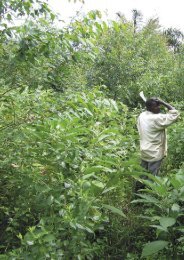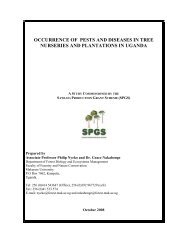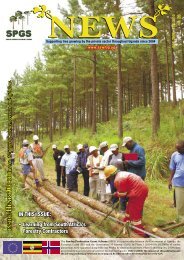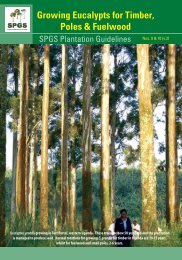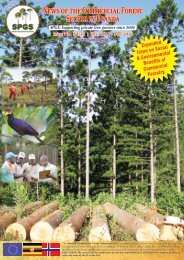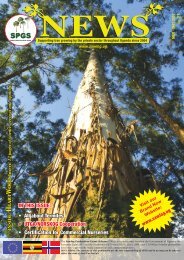Guideline No.12 - Gr.. - SPGS
Guideline No.12 - Gr.. - SPGS
Guideline No.12 - Gr.. - SPGS
You also want an ePaper? Increase the reach of your titles
YUMPU automatically turns print PDFs into web optimized ePapers that Google loves.
9. Pre-Plant Weeding See Section 13.10. Timing of PlantingThe same rule applies for all plantation species:namely, plant as early as possible in the rainyseason. This gives the young trees the maximumchance of establishing themselves well before theonset of the hot, dry period that follows each rainyseason in Uganda. Normal (‘dry’) planting canusually take place when >50mm of rain has beenreceived – but this depends on a number of sitespecificfactors and the site must be checked forsoil moisture down to at least 25mm depth beforedeciding to plant.Depending on the region (and the season), thebest times to plant are usually early in either of thetwo rainy seasons experienced in most of the mainplantation regions in Uganda (normally March/Apriland Sept/Oct). The use of super-absorbants (e.g.Aqua-Soil) can also extend the planting time.11. Beating Up Always plan to raise (or order) up to 15% extra plantsto replace the failures from the initial planting.Preferably within two weeks of the initial planting,carry out a quick survival check by counting thefailures in a sample number of lines. Generally if thesurvival is below 90% (i.e. over 10% deaths), blankingis recommended. In the blanking operation it isimportant to use the same seedling stock that wasused for the original planting. Late blanking andusing different seed stock from the original plantingare the main causes of variability in Ugandanplantations. For further details refer to <strong>SPGS</strong> Plantation<strong>Guideline</strong> No. 23 – Planting & Beating Up.Blanking in season following the initial plantingis not recommended except in exceptionalcircumstances, as it will inevitably lead tovariability in the plantation.12. FertilisingIt has generally not been common practise tofertilise pine crops in many tropical or sub-tropicalcountries. South African research, however, hasshown sustained response of pines to P (Phosphorus)applications on some sites. In Queensland, Australia,fertilisers have produced a very significant responsein conjunction with site cultivation but these are verypoor (infertile) sites compared to most of Uganda.Specific sites in Madagascar and Nigeria have also The term beating up refers to the replacementof failures: it is also known as infilling or blanking– depending on where you are from!A high quality PCH seedling (within the <strong>SPGS</strong> recommendedsize limits 15-25mm) just planted onto well prepared (andweeded) soil.shown good responses to fertiliser but it is highlydependent on the site’s nutrient status. At thisstage in Uganda, however, we do not recommendfertilising pines in Uganda, until research proves it tobe worthwhile.13. WeedingThere is no point wasting time and money onpreparing the planting site to a high standard,planting high quality seedlings and then neglectingweeding – and yet this is exactly what many treeplanters in Uganda are doing!As emphasised throughout this series of Plantation<strong>Guideline</strong>s, weed control starts well before planting.The aim is to control problem weeds beforeplanting and then to keep any subsequent weedsto a minimum. Where there is a predominanceof tough, perennial grasses and tall broadleavedweeds, for example, we recommend a pre-plantspray with Glyphosate, carefully timed to minimizethe period between spraying and planting.Following planting, a manual spot (or ring) weedis generally recommended for all pine species,to minimise competition and ensure good growthof the trees. The aim of this operation is to create



